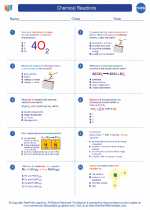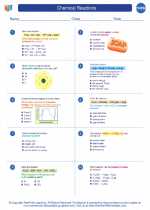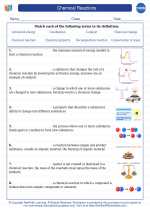Chemical Equations
Chemical equations are symbolic representations of chemical reactions. They depict the reactants, products, and the stoichiometry of the reaction. A balanced chemical equation shows the conservation of mass and the molar ratios of the reactants and products.
Parts of a Chemical Equation
- Reactants: The substances that are consumed in the reaction and are written on the left-hand side of the equation.
- Products: The substances that are formed in the reaction and are written on the right-hand side of the equation.
- Arrow: The arrow (→) separates the reactants from the products, indicating the direction of the reaction.
- Coefficients: Numbers placed in front of the chemical formulas to balance the equation and represent the relative amounts of reactants and products.
- Subscripts: Numbers written to the lower right of the chemical symbol to indicate the number of atoms of that element in a molecule.
Balancing Chemical Equations
When writing a chemical equation, it is important to balance it to satisfy the law of conservation of mass. This means that the number of each type of atom on the reactant side must be equal to the number of the same type of atom on the product side.
The steps to balance a chemical equation are:
- Write the unbalanced equation.
- Count the number of atoms of each element on both sides of the equation.
- Adjust the coefficients of the compounds to make the number of each type of atom the same on both sides.
- Check to ensure that the equation is balanced.
Types of Chemical Reactions
Chemical reactions can be classified into several types, including:
- Combination (Synthesis) Reaction: Two or more substances combine to form a single product.
- Decomposition Reaction: A single compound breaks down into two or more simpler substances.
- Single Replacement (Displacement) Reaction: An element replaces another element in a compound, resulting in the formation of a new compound and a different element.
- Double Replacement (Displacement) Reaction: The cations and anions of two different compounds switch places, forming two new compounds.
- Combustion Reaction: A substance reacts with oxygen, often producing heat and light as well as one or more products.
Understanding the types of chemical reactions helps in writing and balancing chemical equations.
Key Concepts to Remember
When working with chemical equations, it's important to remember the following key concepts:
- Always balance the chemical equation to satisfy the law of conservation of mass.
- Pay attention to the states of matter (solid, liquid, gas, aqueous) of the reactants and products, as they can affect the reaction conditions.
- Use the correct chemical formulas and charges for ionic compounds and polyatomic ions when writing equations.
By understanding the components of a chemical equation, the process of balancing equations, the types of chemical reactions, and the key concepts, you can effectively analyze and interpret chemical reactions.
Study Guide:
1. Define a chemical equation and explain its components.
2. Describe the process of balancing a chemical equation and provide an example.
3. Classify and explain the different types of chemical reactions, providing an example for each type.
4. Discuss the importance of balancing chemical equations in relation to the law of conservation of mass.
By mastering these concepts, you will be well-equipped to tackle problems related to chemical equations and reactions.
.◂Chemistry Worksheets and Study Guides High School. Chemical Reactions

 Worksheet/Answer key
Worksheet/Answer key
 Worksheet/Answer key
Worksheet/Answer key
 Worksheet/Answer key
Worksheet/Answer key
 Worksheet/Answer key
Worksheet/Answer key
 Worksheet/Answer key
Worksheet/Answer key
 Vocabulary/Answer key
Vocabulary/Answer key
 Vocabulary/Answer key
Vocabulary/Answer key
 Vocabulary/Answer key
Vocabulary/Answer key
